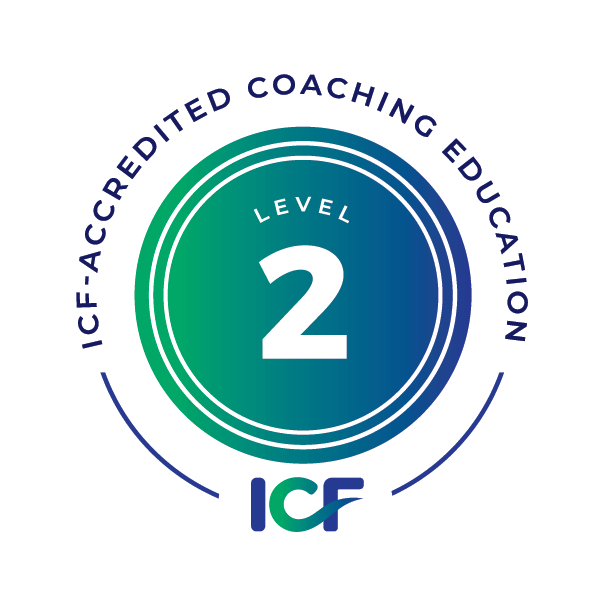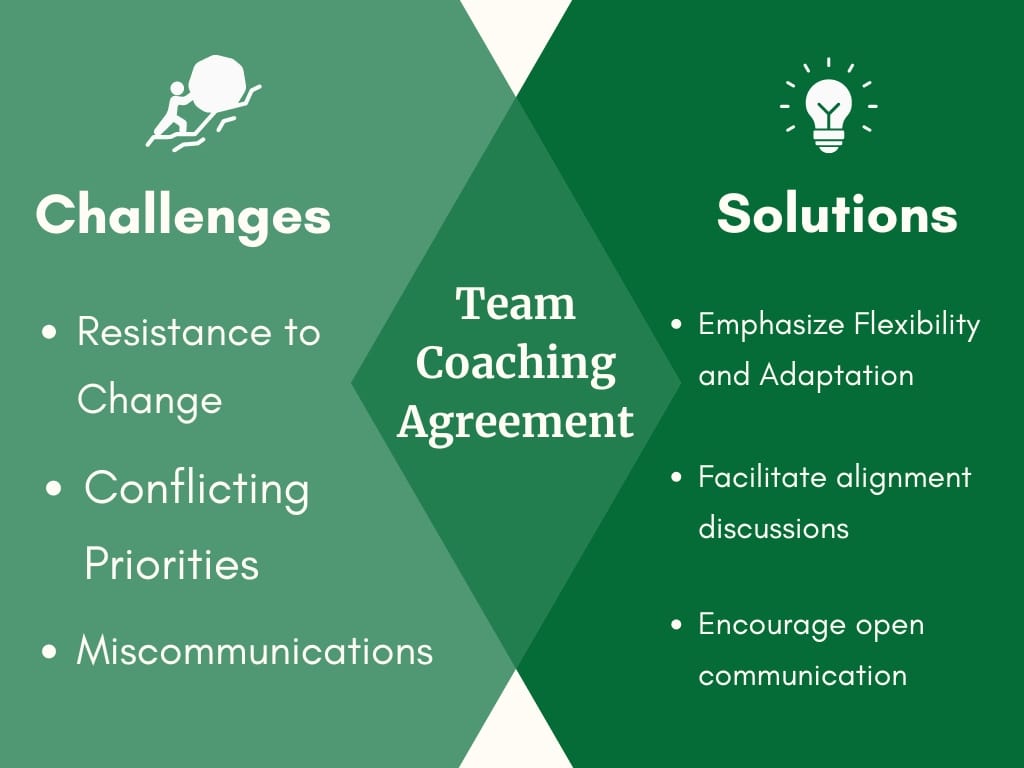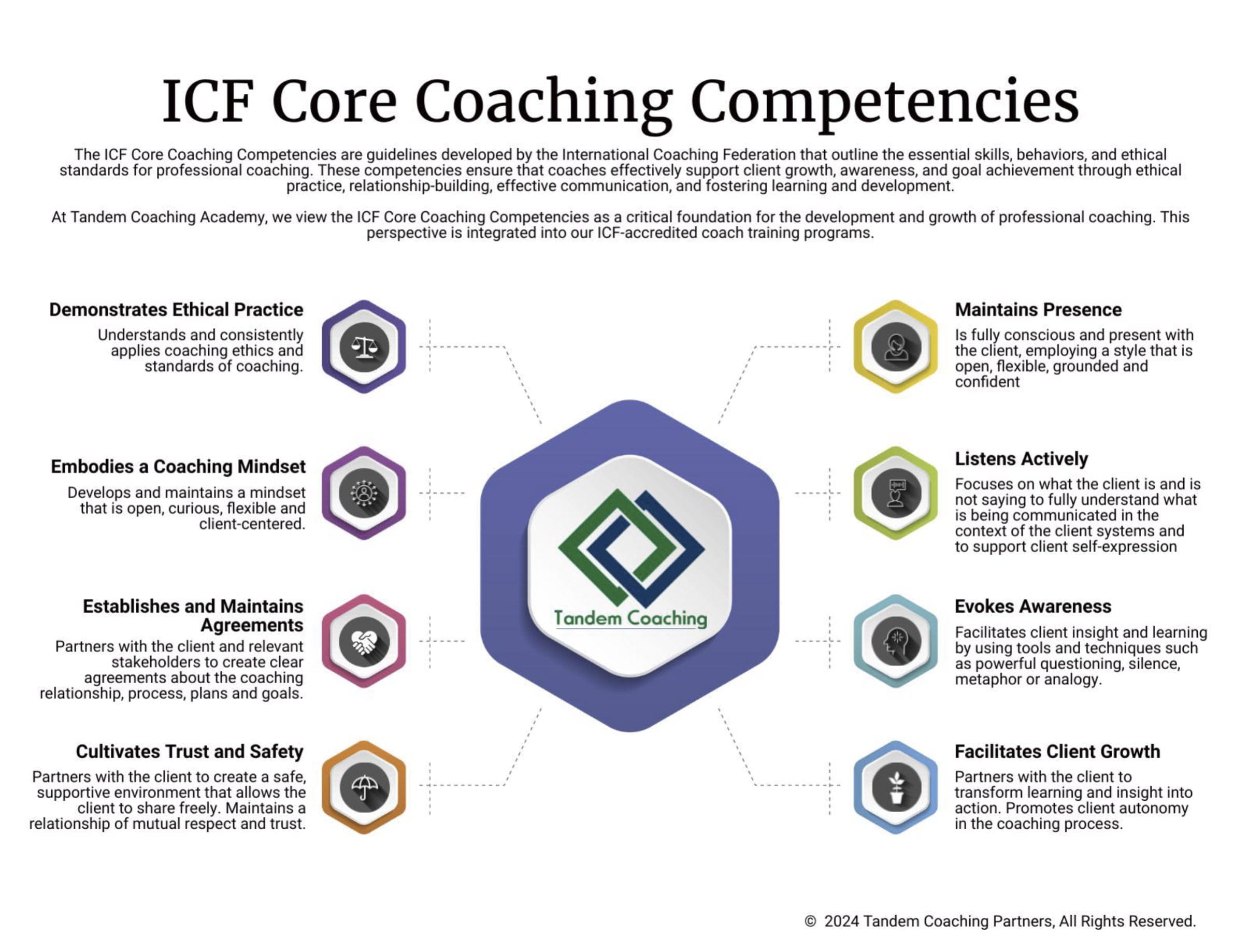Establishing and maintaining agreements is one of the most crucial aspects of team coaching, especially for those pursuing ICF ACTC certification. Team dynamics are complex, and without clear, well-defined agreements, teams risk misalignment, miscommunication, and diminished performance. This article dives into the ICF Team Coaching Competency: Establishing and Maintaining Agreements, offering practical steps and insights on how to co-create and uphold agreements that empower teams to perform at their best. We’ll explore strategies, challenges, and best practices, ensuring you’re equipped to lead teams to success.
Through this article, you’ll gain a clear understanding of how to initiate and maintain agreements within team coaching engagements, the importance of flexibility, and why this competency is integral to achieving certification. If you’re working towards the ACTC or seeking to improve your team coaching skills, you’ll find actionable insights that address common concerns, such as handling team misalignment and navigating shifting goals.
By the end, you’ll know exactly how to guide your teams through the agreement process and keep them on track. For more on the full spectrum of team coaching competencies, explore other ICF competencies here.
Quick Wins: Essential Takeaways for Establishing and Maintaining Agreements in Team Coaching
- Clarity First: Clear agreements lay the foundation for team alignment, ensuring everyone understands their roles, goals, and responsibilities.
- Ongoing Process: Maintaining agreements requires revisiting them regularly as team dynamics evolve.
- Flexibility Matters: Adaptability is key when managing agreements in changing environments.
- Overcoming Challenges: Be prepared for obstacles like miscommunication or conflicting priorities within the team.
- Certification Edge: Mastering this competency is crucial for those pursuing ICF ACTC certification, boosting your team coaching expertise.
Introduction to Team Coaching Agreements
In team coaching, one of the most critical steps is establishing agreements that foster alignment and cooperation. Unlike individual coaching, where the coach works one-on-one with a client, team coaching requires an understanding of group dynamics, shared goals, and individual contributions. Without clear agreements, the team risks confusion, inefficiency, and misaligned expectations.The ICF Team Coaching Competency: Establishing and Maintaining Agreements focuses on co-creating a foundation that guides the team’s journey. This competency ensures that every individual in the team understands the coaching process, their respective roles, and how they’ll work together toward common objectives. Agreements provide a framework that promotes trust, accountability, and a shared sense of ownership.For instance, a leadership team undergoing a coaching engagement may begin by setting a coaching agreement that clarifies what the process involves, how confidentiality is maintained, and the expected outcomes. This establishes mutual trust between the coach and team, ensuring everyone is aligned on how coaching will support the team’s development. As a result, the team experiences greater cohesion, fewer miscommunications, and clearer progress toward their objectives.Coaching agreements in team coaching are not static. They need to evolve, reflecting the progress of the team, new challenges, or changing goals. Coaches must ensure these agreements stay relevant and facilitate the team’s ongoing development.“A coaching agreement sets the foundation for a productive relationship—it aligns expectations and builds trust from day one.”For more information on how coaching agreements integrate into broader ICF competencies, visit ICF Team Coaching Competencies.

Discover ICF PCC and ICF ACTC Team Coaching Competencies and Mastery
Are you eager to magnify the impact of your coaching practice?
Our ICF Team Competencies program offers a seamless transition for those who have mastered the core competencies, allowing you to delve deeper into the complexities and rewards of team coaching.
Explore this opportunity today.
Why Clear Agreements are Critical in Team Coaching
In team coaching, clear agreements are essential for creating alignment and building trust. Unlike individual coaching, where only one person’s objectives and expectations need to be addressed, team coaching involves multiple individuals with varying roles and perspectives. Without a clear coaching agreement, misalignment and confusion are almost inevitable.A well-crafted coaching agreement clarifies expectations, goals, and the process itself. This might include logistical details, such as the duration of coaching sessions and confidentiality, as well as specifics around the desired outcomes and each team member’s role in the process. By addressing these elements upfront, coaches can create a solid foundation for collaboration, ensuring that everyone is on the same page.For instance, a coaching engagement might begin by establishing a clear agreement about the roles of each team member in the process, the expected outcomes, and how progress will be measured. This ensures that the team understands how the coaching will support their development and what is expected from each participant.“A clear coaching agreement sets the stage for accountability, trust, and a shared commitment to progress.”For more insight into the importance of coaching agreements, check out the broader ICF Coaching Competencies.
Step-by-Step Process for Establishing Agreements
Establishing coaching agreements using the STORMMES model focuses on the collaborative process, ensuring the agreement is functional and aligned with the team’s objectives. The emphasis here is on the existence and mutual understanding of the agreement, not on documentation. Here’s how you can guide teams through the process:
1. Subject
Start by defining the core subject of the coaching engagement. This focuses on the team’s primary goals and what they want to achieve.
2. Time
Establish a time frame for the coaching process. While flexibility is important, setting a general timeline helps ensure progress is made.
3. Outcomes
Agree on specific outcomes that will measure the team’s progress. These should be concrete and measurable, allowing the team to stay accountable to their goals.
4. Roles
Clarify who is responsible for what. In team coaching, each individual has a unique role, and defining these roles reduces confusion during the engagement.
5. Measures
Determine how success will be measured. This could be based on key performance indicators (KPIs) or other metrics relevant to the team’s goals.
6. Meaning
Explore the significance of the goals to the team. Ask, “Why are these goals important?” Understanding the meaning behind the goals builds a deeper connection and commitment to the process.
7. Environment
Assess external factors that could either support or hinder the team’s progress. As a coach, asking questions like, “What external influences should I be aware of?” helps create strategies to navigate challenges.
8. Start
Agree on when to begin and set the pace for the coaching engagement. A clear start date helps establish momentum for the process.
“A meaningful coaching agreement is a living process—it grows with the team and adapts to new challenges.”
For more on how the STORMMES model can be applied in coaching, visit the STORMMES Coaching Agreement Tool.

Maintaining Agreements Throughout the Coaching Engagement
Establishing a coaching agreement is only the beginning. Maintaining that agreement throughout the engagement is equally important, as team dynamics and external conditions evolve. A coach must continuously assess whether the original agreement still serves the team’s needs or if it requires adjustment.
Regular check-ins with the team are essential to ensure the agreement is working as intended. As the team progresses, some aspects of the agreement—such as roles or outcomes—might need revision. Flexibility is key; rigidly sticking to an outdated agreement can hinder progress rather than facilitate it.
For example, during a team coaching engagement, roles might shift as new projects emerge, or external factors may alter the team’s focus. This is where a coach’s adaptability comes in. Revisiting the environment—external conditions that could support or impede the coaching process—can also reveal new challenges or opportunities that were not originally considered. A coach should facilitate discussions on these changing conditions, helping the team navigate them while keeping the agreement relevant and effective.
“A successful agreement isn’t static—it evolves with the team’s journey, allowing for growth and adaptation.”
Coaches should encourage team members to voice concerns or suggest adjustments during these check-ins. This promotes ongoing transparency and keeps everyone aligned with the coaching goals. Learn more about maintaining team coaching agreements at ICF Team Coaching Competencies.
Common Challenges in Establishing and Maintaining Agreements
Establishing and maintaining coaching agreements can present several challenges, especially in team coaching, where multiple individuals with varying expectations and roles are involved. These challenges, if not addressed early, can derail the coaching process.
Miscommunication
One of the most common challenges is miscommunication. With different team members interpreting agreements in their own ways, confusion can arise about roles, goals, or processes. To overcome this, coaches should emphasize clarity from the beginning and encourage open communication.
Conflicting Priorities
Teams often consist of individuals with different priorities, which can lead to friction. For instance, one part of the team may focus on short-term deliverables, while another is more concerned with long-term strategic goals. The coach’s role here is to facilitate conversations that bridge these differences and find common ground.
Resistance to Change
Agreements are not static, and some team members may resist revisiting or adjusting them as the engagement evolves. This resistance can stem from a desire for stability or discomfort with uncertainty. Coaches must guide teams through the importance of flexibility and the need for adaptation when circumstances change.
“Challenges are inevitable, but they present opportunities for growth when approached with open communication and a willingness to adapt.”
For more insight on overcoming these challenges, explore ICF Team Coaching Competencies.

Real-World Examples of Successful Team Coaching Agreements
Clear coaching agreements are essential to team success, especially in dynamic environments. Here are a few real-world examples that showcase their impact:
Cross-Departmental Leadership Teams: In one instance, a leadership team was struggling with role confusion across departments. By establishing an agreement that clarified roles and created a feedback loop, the team achieved smoother communication and faster decision-making.
Agile Teams Adapting to Change: An agile development team introduced coaching to handle shifting project priorities. The agreement focused on outcomes and flexibility, allowing the team to respond quickly to evolving customer demands without sacrificing quality. Regular reassessments of the agreement kept the team adaptable.
Remote Teams Facing Communication Barriers: A fully remote team was facing issues with communication, leading to project delays. Through a coaching agreement that emphasized the environment—focusing on external distractions and work schedules—the team was able to develop strategies for better coordination, resulting in improved project flow and collaboration.
Crisis Management Teams: During an organizational restructuring, a crisis management team leveraged coaching agreements to align new leadership with urgent company goals. These agreements established a structure for open dialogue and clear action plans, which helped the team navigate through uncertainty more efficiently.
“Successful coaching agreements allow teams to face their unique challenges head-on, ensuring that flexibility and adaptability are always part of the plan.”
Differences Between Team and Individual Coaching Agreements
While both team and individual coaching agreements are foundational, their scope and complexity differ significantly. In individual coaching, agreements typically focus on one person’s goals, roles, and confidentiality, creating a clear, straightforward framework. In contrast, team coaching involves multiple participants, each with their own roles, perspectives, and responsibilities. The agreement must address group dynamics, collective outcomes, and how members will collaborate.
For instance, a team coaching agreement may include provisions for conflict resolution among members, which would be irrelevant in a one-on-one coaching scenario. In team settings, it’s also essential to ensure that all members contribute to shaping the agreement, fostering mutual accountability and commitment.
Additionally, the environment plays a larger role in team coaching agreements. In teams, external factors—such as organizational culture, leadership shifts, or even market pressures—may significantly impact the coaching process. Coaches must consider these broader influences when establishing agreements with teams.
“The complexity of team coaching agreements lies in balancing individual needs with collective goals, ensuring alignment without losing sight of the team’s bigger picture.”
Best Practices for Establishing Effective Agreements
Establishing effective team coaching agreements involves several best practices that ensure clarity and alignment.
- Involve Everyone: Team agreements must be co-created with input from all members. This guarantees buy-in and collective ownership of the process.
- Define Measurable Outcomes: It’s crucial to set clear, measurable goals so that progress can be easily tracked. These outcomes should be specific and agreed upon by the team.
- Encourage Open Dialogue: An effective agreement fosters transparency. Team members should feel comfortable sharing concerns, asking for adjustments, and revisiting the agreement as needed.
- Maintain Flexibility: As team dynamics evolve, so should the agreement. A rigid agreement can stifle growth, whereas one with built-in flexibility allows the team to adapt to new challenges and opportunities.
By following these best practices, coaches can help teams establish agreements that not only set the groundwork for success but also grow alongside the team’s progress.
“An effective coaching agreement is flexible, collaborative, and constantly evolving to meet the team’s changing needs.”
Maintaining Agreements: The Coach’s Role in Long-Term Success
Maintaining agreements requires active involvement from the coach throughout the coaching engagement. While the agreement provides a solid foundation, it’s the coach’s responsibility to ensure it remains relevant and effective as the team grows and faces new challenges.
Regular Reassessment
The agreement should be revisited regularly, especially when the team undergoes changes or achieves milestones. The coach plays a key role in facilitating this process, helping the team assess whether the agreement is still serving its purpose. This ensures the coaching remains aligned with the team’s evolving objectives.
For example, if a team’s goals shift due to external factors—such as market changes or internal restructuring—the coach should prompt discussions about how the agreement might need to be adjusted. This continuous evaluation helps the team stay on track without losing sight of their original purpose.

Encouraging Adaptability
Another crucial aspect of maintaining agreements is fostering a sense of adaptability within the team. Teams that are rigid in their adherence to initial agreements may struggle when unforeseen circumstances arise. The coach must instill the idea that agreements are not set in stone but are living frameworks that must evolve.
Coaches can use regular check-ins to review roles, outcomes, and measures, and address any emerging challenges or opportunities. This creates a culture where the team is proactive about adapting their agreement to better suit their needs.
Conflict Resolution and Realignment
Even with a solid agreement in place, teams may still encounter conflicts or disagreements. The coach’s role here is to help the team revisit their original commitments, using the agreement as a tool for conflict resolution. By referring back to the agreed-upon goals, roles, and measures, the coach can guide the team in realigning their efforts and maintaining focus.
For example, in teams where roles overlap or responsibilities are unclear, the coach can facilitate discussions to redefine these aspects, preventing further conflict and ensuring that the agreement continues to support team cohesion.
Conclusion: The Value of Strong Agreements in Team Coaching
Strong coaching agreements are the cornerstone of any successful team coaching engagement. They provide clarity, foster accountability, and create a shared understanding that aligns the team toward common objectives. As the team evolves, so too must the agreement. Coaches play a critical role in guiding teams through the creation and ongoing maintenance of these agreements, ensuring that they remain relevant and adaptable to new challenges.
By following best practices like regular reassessment and open communication, teams can ensure that their agreements continue to support their goals. Flexibility and clarity are key to maintaining alignment, and as a coach, your role in facilitating this process is crucial to long-term success.
“The coaching agreement is a dynamic framework, ensuring teams remain focused, aligned, and adaptable throughout the engagement.”
Ready to strengthen your team coaching skills? Explore how Tandem Coaching can help you master the art of creating and maintaining coaching agreements with our ACTC certification program. Gain the expertise you need to facilitate team alignment and drive meaningful outcomes. Learn more about our ACTC Team Coaching Program and take the next step in your coaching journey today.
Frequently Asked Questions about Team Coaching Agreements
What is the purpose of a coaching agreement in team coaching?
A coaching agreement in team coaching defines the process, expectations, and goals for the entire team. It sets the foundation for alignment, ensuring that every team member is clear on their role and the overall objectives. This agreement creates accountability and fosters trust within the group. For more details on its importance, explore ICF Team Coaching Competencies.
How does the STORMMES model help in creating coaching agreements?
The STORMMES model—Subject, Time, Outcomes, Roles, Measures, Meaning, Environment, and Start—provides a structured framework for establishing coaching agreements. It ensures that all key areas are addressed, leading to a comprehensive and flexible agreement that serves both short-term and long-term team goals. For a deeper understanding, check out the STORMMES Coaching Agreement Tool.
How often should a team coaching agreement be revisited?
Coaching agreements should be revisited regularly, especially after major milestones or when team dynamics shift. Regular reassessment helps keep the agreement relevant and ensures it continues to support the team’s progress. Depending on the team’s needs, coaches may review agreements monthly or quarterly. Learn more about maintaining agreements at ICF Team Coaching Competencies.
What is the difference between team coaching agreements and individual coaching agreements?
In individual coaching, the agreement focuses on personal goals, confidentiality, and one-on-one expectations. In team coaching, agreements are more complex, involving multiple individuals with potentially conflicting priorities. Team coaching agreements address group dynamics, collaboration, and collective outcomes, making them more adaptable and fluid. For more, visit ICF’s Team Coaching Overview.
What challenges can arise when establishing coaching agreements in teams?
Common challenges include miscommunication, conflicting priorities, and resistance to change. Teams may struggle to align around shared goals, and external factors can impact the coaching process. Overcoming these challenges involves open communication, flexibility, and regular reassessment of the agreement. For more on handling these issues, refer to our section on Common Challenges in Coaching Agreements.
How do measurable outcomes in coaching agreements impact team performance?
Measurable outcomes provide clarity and accountability, helping teams track progress toward their goals. By defining success early in the agreement process, teams can stay focused and motivated. Clear metrics also allow for adjustments when necessary, keeping the team on course. These outcomes are essential for effective team coaching agreements. More on this topic can be found in our section on Best Practices for Agreements.
What role does a coach play in maintaining the coaching agreement?
A coach facilitates the process of maintaining agreements by checking in with the team regularly, encouraging open dialogue, and helping adapt the agreement when necessary. Coaches ensure that the agreement stays relevant as the team evolves and that it continues to support team alignment and progress.
Can coaching agreements help resolve conflicts within the team?
Yes, coaching agreements can serve as a framework for conflict resolution by referring back to the original roles, goals, and processes agreed upon. When conflicts arise, the coach can guide the team in revisiting the agreement to realign their focus and resolve misunderstandings. This realignment helps prevent further discord and keeps the team moving toward its objectives.
Why is flexibility important in a coaching agreement?
Flexibility is essential because team dynamics and external factors are constantly changing. A rigid agreement may become obsolete if circumstances shift, while a flexible agreement allows the team to adapt without losing sight of the overall goals. This adaptability is key to long-term success in team coaching.
What should be included in the “Environment” section of a coaching agreement?
The Environment section addresses external factors that could support or hinder the team’s progress. This might include organizational culture, leadership changes, or personal commitments that affect team members’ ability to participate fully in the coaching process. By considering these factors, the coach can better tailor the coaching engagement to the team’s needs.

Unlock Your Coaching Potential with Tandem!
Dive into the essence of effective coaching with our exclusive brochure, meticulously crafted to help you master the ICF Core Coaching Competencies.
"*" indicates required fields
About the Author
Cherie Silas, MCC
She has over 20 years of experience as a corporate leader and uses that background to partner with business executives and their leadership teams to identify and solve their most challenging people, process, and business problems in measurable ways.












